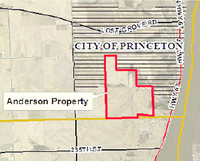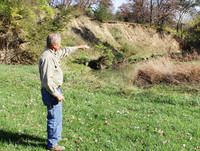






The views atop Paul and Marijo Anderson family’s river bluff property near Princeton extend north to Camanche, south past LeClaire and east across a wide bend of the Mississippi River into Illinois.
Marijo said it’s time others enjoy those views.
Later this month, the Scott County Board of Supervisors will consider the couple’s request to change the land’s zoning and begin a process she hopes will turn the 350 acres into a corporate campus and perhaps large-lot homes.
Those development plans are the biggest along a stretch of U.S. 67 where former Illinois congressman Bobby Schilling is transforming 15 acres purchased from the Olathea Golf Course into a four-home subdivision, including his own home now under construction. Olathea owner Sue Leander says she is eager to see her entire 100-acre golf course developed for homes or recreation.
In all, that’s almost 500 acres of county river bluff land targeted for development between LeClaire and Princeton.
Marijo Anderson researched and visited corporate campuses that incorporate commercial and recreational uses, including Google, Microsoft, Kohl’s and Chemical Abstracts, a Columbus, Ohio office complex that includes hiking trails and outdoor performance spaces for weekend events.
“This land is destined for a great purpose, whether we define it in the next year or so, or over the next 10,” Marijo said.
Their prime interest is in a corporate campus, as well as private homes.
“There’s enough room here for houses and a whole lot of other stuff,” said Paul, who is developing property in Eldridge for single- and multi-family homes.
The Andersons’ plans near Princeton require the county to do something that sparked controversy back in 2012: Take farmland out of agricultural preservation, or AP zoning intended to protect farmland forever. But the Andersons and county officials say this rezoning is entirely different from a Walcott landowner’s attempt to sell high-producing AP land to Orascom, the Egyptian fertilizer firm.
“That was flat black, high CSR land,” Marijo Anderson said. “This is not awesome farmground. But it’s beautiful.”
Maps show a variable terrain with electric and gas line easements. A ride through the property shows sandy brown soil and steep terrain with portions tillable only with narrow equipment and highly erodible.
Paul Anderson’s memory is much more specific.
“That’s where I tipped the tractor,” he said, pointing to a slope where he cut hay for many years. Later, he notes an eroding bend of mud creek that’s already claimed big trees. “Try stacking bales on a 25-percent grade.”
Though portions have been leased for farming, Marijo Anderson said, “Row cropping is the worst use for this land.”
Scott County Planning and Zoning Commission members voted 5-1 to change the zoning from AP, to agriculture general, which allows farm and farm-related uses, and often is used as a holding zone for development prospects. The P&Z recommendation goes to the full county board, which is scheduled to take the first of three rezoning votes Nov. 17. Once zoned AG, the land can be more quickly rezoned for development.
The Andersons have their own vision for the property. The hills still farmed by Paul’s uncle Jim Hamilton are better suited to a corporate campus fitting around the existing stream, hardwood stands and steep hills, they say. They do not intend piecemeal residential development or industrial uses. And she doesn’t expect rapid development.
“We want to be good stewards of property that is unlike anything in Iowa,” Marijo Anderson said.
The property briefly was referenced during the Orascom process in 2012. Anderson provided the P&Z Commission with a property description written by Stanley Management Consultants at that time, which touted the property’s easy rail and utility access. Major gas and electrical lines cross the property and go east to Illinois.
“This Scott County property features a unique bi-state opportunity for the Egyptian fertilizer and construction company Orascom Construction,” the firm wrote.
Marijo Anderson said the couple had no discussions with Orascom, which abandoned its Walcott plans and is still building south of Burlington in Lee County, Iowa.
Anderson said the portion of their property closest to the river had been marketed for commercial development with the Quad-Cities Chamber of Commerce and the Iowa Economic Development Authority.
“We’ve had the front 50 listed with Tara Barney and Deb Durham at least five years,” she said, referencing directors of the Q-C Chamber and IEDA.
Scott County Planning Director Tim Huey told county supervisors the terrain and location make it rough for farming, but ideal for residential or office development. “I can’t imagine it being appropriate for real heavy industry,” he said.
County P&Z Commission Chairman Clayton Lloyd supported rezoning as, “kind of a nudge toward development. I don’t expect we’re going to see in the next several months a 350-acre residential subdivision. Perhaps some pieces will be broken off. It will be important to see how the first piece, or set of pieces, goes.”
P&Z Commissioners Tony Knobbe, Clayton Lloyd, Lynn Gibson, Carolyn Scheibe and Marsha Findlay voted to change the zoning.Commissioner Dan Portes was not present.
Commissioner Hans Schnekloth cast the sole opposing vote. Contacted after the meeting, he said he needed more details.
“The simple answer is I didn’t appreciate the lack of a plan. I didn’t quite understand the urgency to get it down-zoned from AP to AG. I’m not opposed to an alternate use for a property. If they had a plan put together, it wouldn’t take long to go step one AP to AG, then AG to R-1 or something else.”
He also said the commission didn’t know the average corn suitability rating when it voted on rezoning. “To me it felt a little vague. We didn’t know average crop suitability rating.”
Since then, Huey reported a wide range of CSR ratings, averaging about 53, well below the top rating of 100.
Schnekloth also said he wanted more details about annexation. “We didn’t know from Princeton definitively if they had an interest in annexation. There were a few questions I wanted answered.”
Lloyd confirmed no discussion about annexation possibilities.
Two Princeton council members confirmed there have been no discussions about annexing the Anderson property, which abuts Princeton’s south and west boundaries.
“This has not come before the council,” council member Ann Geiger said. “There has been no discussion of the rezoning by the council … The only discussion we’ve ever had about annexation is on the north end … Annexation is not just a slam dunk for us. We think about it carefully, especially the infrastructure.”
Council member Brian Carter confirmed no council discussion of annexing the property. He agreed that water, sewer and street infrastructure would be a high hurdle for Princeton, which already is discussing up to $4 million in sewer and water improvements to accommodate existing residents. But he was optimistic that more specific development prospects would make annexation talks worth pursuing.
“I think there would be interest, if we can make it work. We’d need to know what are they going to do? What type of development? Will it be his, Paul’s or handed off to Realtors?” Carter said.
Carter was raised near the property and shared treasured memories of the land and its views while growing up with the Andersons. “It really is special,” he said.
Marijo recalls horseback rides over the hills, and a more specific adventure when she and Paul were teenagers. The young couple climbed into a six-wheeled ATV, “and flew over the hills,” Marijo recalled. Paul steered them down a steep slope and directly onto a frozen, snow-covered Mississippi River.
“Can you imagine?” she said, reflecting 40 years later on the danger. She recalls holding tight as Paul swept the vehicle in a big arc over the ice, fishtailed a bit, then completed another arc back to the bank and up the hill.
“When I turned around, I saw he’d left a trail of a giant heart on the ice,” she said.
Paul grinned, then agreed both would have freaked out if their kids pulled the same stunt.
His grandparents’ vacant home remains and is set for demolition. Paul’s sister lives in another home with a pasture for a few goats. Paul farmed the hills until 1990, when farming was taken over by his uncle Jim. Jim, now in his 80s, shared a similar love for land he said, “always looked better than it produced.”
“Those weren’t easy rows,” he said, gesturing to a slope above the old homestead, where a tenant disked corn stubble Saturday morning.
Olathea development under way
Less than two miles south of the Anderson’s property, county supervisors have replatted part of the Olathea Golf Course property to accommodate Bobby Schilling’s plan for his new home and three developable lots on a similar river bluff.
Schilling installed an access road from U.S. 67, leading to his new home site on Olathea’s former driving range, where the foundation has been poured.
Schilling declined to be interviewed about this development. Supervisors rezoned the property from agriculture general to residential in 2012.
Olathea owner Susan Leander says she hopes to one day sell the entire nine-hole golf course, covering about 100 acres, for residential development. Most of the property currently is zoned commercial.
“The golf course will be running until we sell the land,” she said. “We feel we can gain more by developing this property with such great views.”
She hopes Schilling’s initiative persuades others. “On Schilling’s part, he’s going to sell a few lots. They’re hoping to have their home done by Christmas.” She said her grandkids already are playing with his kids on a trampoline on the property.
Leander added that Schilling already mentioned one prospect. “I have one person interested, but hasn’t gotten it together yet. It’s someone Schilling knows who lives in China now.”